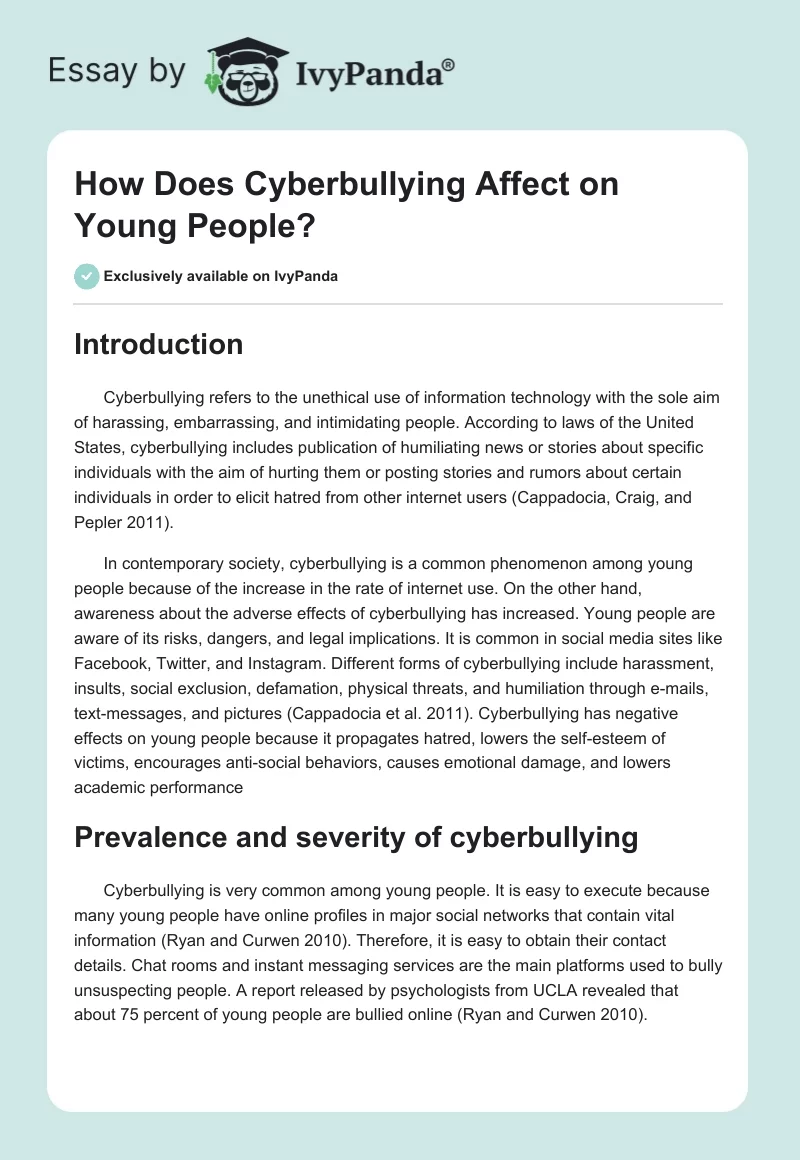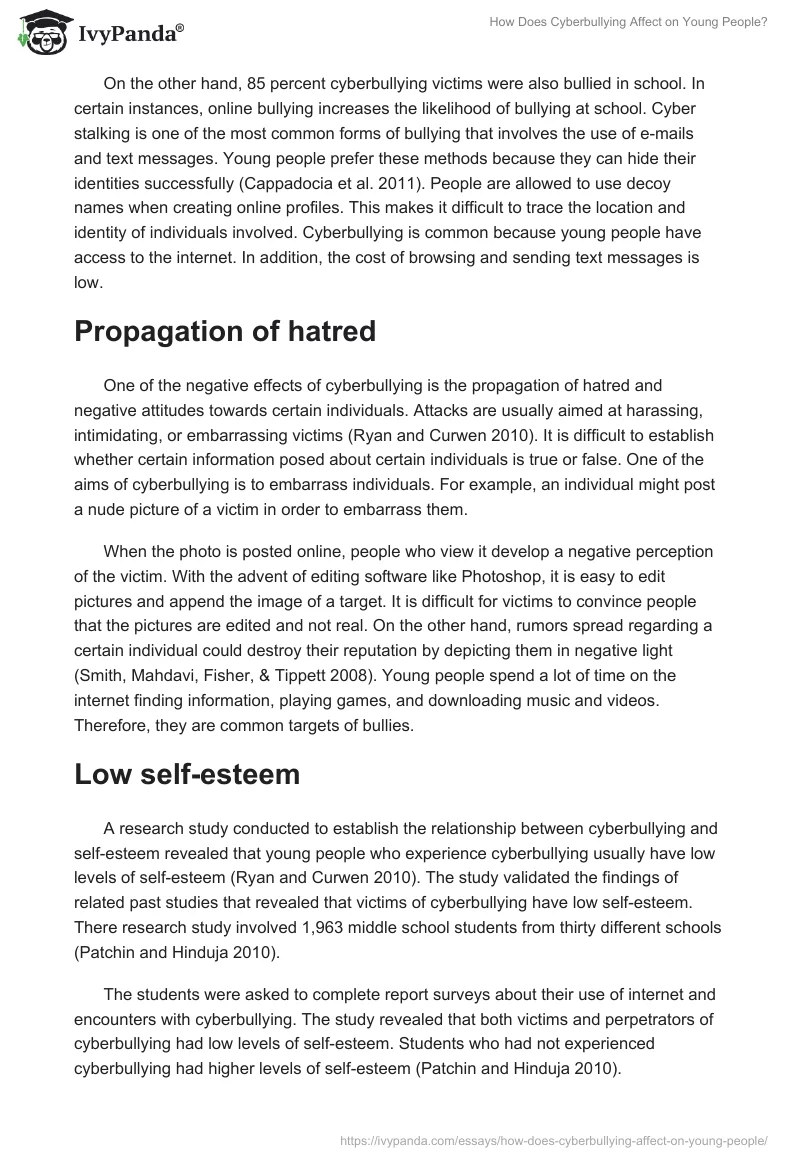Introduction
Cyberbullying refers to the unethical use of information technology with the sole aim of harassing, embarrassing, and intimidating people. According to laws of the United States, cyberbullying includes publication of humiliating news or stories about specific individuals with the aim of hurting them or posting stories and rumors about certain individuals in order to elicit hatred from other internet users (Cappadocia, Craig, and Pepler 2011).
In contemporary society, cyberbullying is a common phenomenon among young people because of the increase in the rate of internet use. On the other hand, awareness about the adverse effects of cyberbullying has increased. Young people are aware of its risks, dangers, and legal implications. It is common in social media sites like Facebook, Twitter, and Instagram. Different forms of cyberbullying include harassment, insults, social exclusion, defamation, physical threats, and humiliation through e-mails, text-messages, and pictures (Cappadocia et al. 2011). Cyberbullying has negative effects on young people because it propagates hatred, lowers the self-esteem of victims, encourages anti-social behaviors, causes emotional damage, and lowers academic performance
Prevalence and severity of cyberbullying
Cyberbullying is very common among young people. It is easy to execute because many young people have online profiles in major social networks that contain vital information (Ryan and Curwen 2010). Therefore, it is easy to obtain their contact details. Chat rooms and instant messaging services are the main platforms used to bully unsuspecting people. A report released by psychologists from UCLA revealed that about 75 percent of young people are bullied online (Ryan and Curwen 2010).
On the other hand, 85 percent cyberbullying victims were also bullied in school. In certain instances, online bullying increases the likelihood of bullying at school. Cyber stalking is one of the most common forms of bullying that involves the use of e-mails and text messages. Young people prefer these methods because they can hide their identities successfully (Cappadocia et al. 2011). People are allowed to use decoy names when creating online profiles. This makes it difficult to trace the location and identity of individuals involved. Cyberbullying is common because young people have access to the internet. In addition, the cost of browsing and sending text messages is low.
Propagation of hatred
One of the negative effects of cyberbullying is the propagation of hatred and negative attitudes towards certain individuals. Attacks are usually aimed at harassing, intimidating, or embarrassing victims (Ryan and Curwen 2010). It is difficult to establish whether certain information posed about certain individuals is true or false. One of the aims of cyberbullying is to embarrass individuals. For example, an individual might post a nude picture of a victim in order to embarrass them.
When the photo is posted online, people who view it develop a negative perception of the victim. With the advent of editing software like Photoshop, it is easy to edit pictures and append the image of a target. It is difficult for victims to convince people that the pictures are edited and not real. On the other hand, rumors spread regarding a certain individual could destroy their reputation by depicting them in negative light (Smith, Mahdavi, Fisher, & Tippett 2008). Young people spend a lot of time on the internet finding information, playing games, and downloading music and videos. Therefore, they are common targets of bullies.
Low self-esteem
A research study conducted to establish the relationship between cyberbullying and self-esteem revealed that young people who experience cyberbullying usually have low levels of self-esteem (Ryan and Curwen 2010). The study validated the findings of related past studies that revealed that victims of cyberbullying have low self-esteem. There research study involved 1,963 middle school students from thirty different schools (Patchin and Hinduja 2010).
The students were asked to complete report surveys about their use of internet and encounters with cyberbullying. The study revealed that both victims and perpetrators of cyberbullying had low levels of self-esteem. Students who had not experienced cyberbullying had higher levels of self-esteem (Patchin and Hinduja 2010).
Low self-esteem emanates from feelings of being vulnerable, powerless, and helpless. These feelings are augmented by the anonymity of offenders. Victims have no ways of protecting themselves and are always at the mercy of offenders hence low levels of self-esteem. Young people with low self-esteem do not enjoy life as much as they should and they engage in behaviors that aid them to forget their experiences. All facets of young people’s lives are affected by low self-confidence and self-esteem. They have low productivity and efficiency both at school and at home (Patchin and Hinduja 2010). Failure by parents to spend time with their children worsens the problem because they fail to offer help to their children before the situation gets worse.
Emotional damage
Cyberbullying increases feelings of anxiety, loneliness, depression, and other stress-related feelings. A study conducted to study the effects of cyberbullying on the emotional states of children revealed that it has negative effects. The study involved 20 students of different ages. The study revealed that victims had persistent feelings of unhappiness, fear, anxiety, powerlessness, helplessness, sadness, embarrassment, and rejection (Hinduja & Patchin 2010).
The main cause of emotional damage is erosion of self-esteem and confidence. Victims feel alone and helpless and therefore, isolate themselves to avoid attacks. In addition, victims lose interest in many activities, develop suicidal ideas, and might finally succumb to depression. Research has shown that victims of cyberbullying report higher instances of depression that victims of physical bullying. Depression has adverse effects on teenagers mainly with regard to proper emotional and psychological development (Ryan and Curwen 2010).
Depressed teenagers lose interest in fun activities, become irritable, develop concentration problems, and develop depression-related disorders (Hinduja and Patchin 2010). One of the consequences of depression is suicidal thoughts and attempted suicide. Research has revealed that victims of cyberbullying are more likely to attempt suicide compared to young people who have never experienced it. Young people usually suffer depression when the pressure of bullying become too much to handle. On the other hand, if they fail to get early intervention from peers, teachers, and parents, they start thinking of suicide as a way of ending their tribulations. Suicide is usually preceded by feelings of anger, fear, worry, anxiety, and loneliness (Ryan and Curwen 2010).
Anti-social behaviors
Victims of cyberbullying usually engage in anti-social behaviors in order to run away from harassment. For example, some engage in drug and substance abuse while others avoid social gatherings. Research to study the relationship between cyberbullying and psychosocial problems revealed that victims showed aggressiveness. The study involved 783 adolescents with the mean age of between 12.1 and 17.5. According to the study, both perpetrators and victims showed signs of aggressiveness. Internalizing problems were observed among victims while externalizing problems were common among perpetrators. Perpetrators of cyberbullying are usually aggressive and violent. Many of them are victims of substance and drug abuse. In order to harass and intimidate victims, some use drugs in order to expel the fear of doing it. Victims of cyberbullying become aggressive as a means of protecting themselves (Hinduja and Patchin 2010).
When developing measures to counter cyberbullying, it is important to study the behaviors of young people to determine whether they have emanated from the effects of bullying or not. The effects of cyberbullying also prevent the participation of young people in physical activities that are good for their health. For example, victims may stop taking part in sports and athletics because they avoid situations that might expose them to bullies. As a result, they become used to sedentary lifestyles that affect their health.
Poor academic performance
Research has established a relationship between academic performance and cyberbullying. Young people who experience cyberbullying usually become disinterested in school because of the need to avoid bullies or the embarrassment and humiliation of online attacks (Smith et al. 2008). For example, if embarrassing pictures of a student are shared online among students in a school, the victim will avoid school as a way of avoiding embarrassment. Absenteeism due to cyberbullying results in poor academic performance. Bullied students get low grades because of inability to concentrate in class or inability to study due to recurrent feelings of anxiety, fear, and helplessness (Smith et al. 2008).
In severe cases, students drop out of school or fail to pursue higher education after graduating from high school. On the other hand, offenders also perform poorly because they spend many days at home due to suspension or expulsion from school for bullying other students (Hinduja and Patchin 2010). Teachers should observe the behaviors of students in order to identify possible victims of cyberbullying in order to offer appropriate assistance. In addition, some students engage in negative school-based behaviors that affect their academic performance (Smith et al. 2008). For example, they spend little time studying and doing homework. Instead, they spend most of their time on the internet bullying other students.
Conclusion
Cyberbullying refers to the use of technology to harass, intimidate, embarrass, or insult. It has negative effects on the lives of young people because it propagates hatred, lowers the self-esteem of victims, encourages anti-social behaviors, causes emotional damage, and increases cases of drug and substance abuse. Students who had not experienced cyberbullying had higher levels of self-esteem. Low self-esteem emanates from feelings of vulnerability, powerlessness, and helplessness. Cyberbullying increases feelings of anxiety, loneliness, depression, and other stress-related feelings. The main cause of emotional damage is erosion of self-esteem and confidence.
Victims feel alone and helpless and therefore, isolate themselves to avoid attacks. In addition, victims lose interest in many activities, develop suicidal ideas, and might finally succumb to depression. In order to harass and intimidate victims, many young people use drugs in order to expel the fear of doing it. Victims of cyberbullying become aggressive as a means of protecting themselves. Student who experience cyberbullying usually become lose interest in school because of the need to avoid bullies. In addition, other students fail to attend school because of the embarrassment and humiliation they get from online attacks. For example, if humiliating statements or stories are given regarding a student, the victim will avoid school because of the humiliation they experience. Absenteeism causes poor academic performance. Such students get low grades because of the inability to concentrate in class or inability to study due to recurrent feelings of anxiety, fear, and helplessness.
References
Cappadocia, C., Craig, W., and Pepler D. (2011). Cyberbullying: Prevalence, Stability and Risk Factors during Adolescence. Canadian Journal of Psychology, 28(2), 171-192. Web.
Hinduja, S., & Patchin, J. (2010). Bullying, Cyberbullying, and Suicide. Archives of Suicide Research, 14(3), 206-222. Web.
Patchin, J., & Hinduja, S. (2010). Cyberbullying and Self-Esteem. Journal of school Health, 80(12), 614-621. Web.
Ryan, K., and Curwen, T. (2010). Cyber-Victimized Students: incidence, Impact, and Intervention. Sage Journals, 4(2), 24-33. Web.
Smith, P., Mahdavi, J., Fisher, S., & Tippett, N. (2008) Cyberbullying: Its Nature And Impact in Secondary Schools. The Journal of Child Psychology and Psychiatry, 49(4), 376-385. Web.


